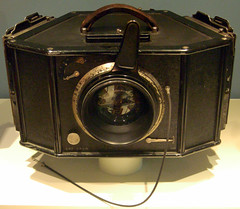Difference between revisions of "Three-color camera"
m (cat architecture/image) |
m (image pool links) |
||
| Line 1: | Line 1: | ||
| − | 3-color cameras divide the incoming light into three different-coloured light bundles, each enlighting separate image planes. | + | 3-color cameras divide the incoming light into three different-coloured light bundles, each enlighting separate image planes, where there are three separate plates, film frames, or digital image sensors. The three images are later combined to form a full-colour image. |
{{Flickr_image | {{Flickr_image | ||
| − | |image_source=http://www.flickr.com/photos/awcam/3112470670/in/pool- | + | |image_source=http://www.flickr.com/photos/awcam/3112470670/in/pool-camerawiki |
|image=http://farm4.static.flickr.com/3077/3112470670_729ac936e2_m.jpg | |image=http://farm4.static.flickr.com/3077/3112470670_729ac936e2_m.jpg | ||
|image_align=right | |image_align=right | ||
| − | |image_text=JosPe 3-colour camera, 1924 | + | |image_text=JosPe 3-colour camera, 1924 |
| + | |image_by= AWCam | ||
| + | |image_rights= With permission | ||
}} | }} | ||
Revision as of 03:28, 19 February 2011
3-color cameras divide the incoming light into three different-coloured light bundles, each enlighting separate image planes, where there are three separate plates, film frames, or digital image sensors. The three images are later combined to form a full-colour image.

|
| JosPe 3-colour camera, 1924 image by AWCam (Image rights) |